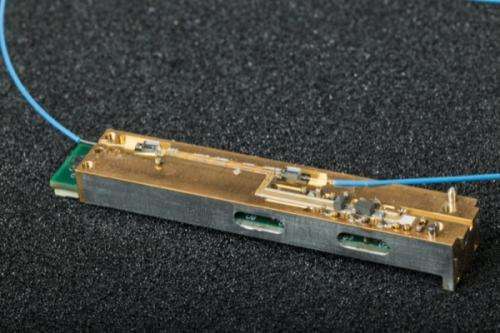Professor brings access to previously untapped higher frequency bandwidth

Society's increasing technology use and data consumption is causing an information bottleneck, congesting airwave frequencies and sending engineers searching for access to higher capacity bandwidths.
Mature technologies, such as radio, operate at lower frequency ranges—for example the 88 to 108 megahertz on the FM radio dial—because it's easy to manipulate. Communications become difficult at larger bandwidths.
For the military, which previously operated radar or communications systems at lower frequencies, finding a way to access these higher frequencies is imperative because civilian networks are increasingly crowded. Until now, no technology has existed to tap into and successfully use these frequencies, which span 30-100 gigahertz.
"It's like having a highway where you can drive 1,000 miles per hour, but there aren't any cars that go that fast," says Dennis Prather, College of Engineering Alumni Professor of Electrical and Computer Engineering.
Prather says he and his team have created a "novel device that opens access to this new bandwidth."
Reaching untapped frequencies
Prather's latest invention, which capitalizes on photonic-based radio frequency systems, offers seven octaves of operation and unprecedented fidelity. It is also multifunctional, allowing the user to transmit everything from voice and data communications, to satellite communications or radar signals.
The device uses a technique of sideband injection locking, which Prather has developed in his lab.
"Think of a piano where every eight keys the notes repeat, just at a higher pitch. The differing pitches are harmonics, or related frequencies, of the first tone," he explains. "If we put a radio signal with an antenna into a custom-made modulator and then connect a laser beam to the device, it generates harmonics."
By inputting a related frequency into the laser beam, Prather is able to generate a shifted harmonic or octave. When mixed, they cancel what is identical, leaving the user with only the signal's difference frequency. The difference is how far apart they are—creating a trustworthy way to "hop" from signal to signal and securely transmit military information.
"The ability to harness the capacity of a spectrum at higher frequencies is huge – no one is saying 'give me a slower network.' We're the first to do it at this frequency, with this kind of fidelity, in this particular way," said Prather, who is working with the Office of Economic Innovation and Partnerships to patent the concept.
"We can make it go anywhere with pinpoint accuracy," he said. Signals can be routed over long distances through lightweight optic fibers and optical components that can be integrated into compact photonic circuits.
The research was recently reported in Nature Photonics, the leading journal in the field. It is funded in part by the Air Force Office of Science Research, the Air Force and other governmental agencies. Co-authors on the paper include Garrett Schneider, the lead author and a UD research associate, and Christopher Schuetz, assistant professor of electrical and computer engineering, both UD alumni.
Schuetz is former chief technology officer of Phase Sensitive Innovations (PSI), a UD spin-off that grew out of his UD doctoral work. In FY 2012 it was the number one federally funded research and development company in the entire state of Delaware. Also involved from UD were research associates Janusz A. Murakowski and Shouyuan Shi.
PSI originally built the modulators used in Prather's new system for passive millimeter wave imagers designed to see through weather conditions such as blowing sand, smoke, clouds or rain. Researchers later realized they could be used to dynamically hop from one place in the spectrum to another, something Prather calls "spread spectrum."
The system's flexibility across multiple information platforms means less equipment to perform multiple functions, less training for operators and a chameleon-like product that can adapt to capture or transmit varying information.
"We want the application to define the limits, not our ability to harness one particular portion of the spectrum," said Prather.
Made from fiber optic cables and nanoscale devices, the lightweight system may ultimately reside on the wings of unmanned aerial vehicles (UAV), or drones.
The next step is to cost efficiently commercialize the technology. Prather has received $1.6 million in new funding to take the technology to the nanoscale, work that will likely include collaboration with Department of Electrical and Computer Engineering colleague Michael Hochberg, and that could ultimately occur in the nanofabrication facility planned for UD's Interdisciplinary Science and Engineering Laboratory (ISE Lab).
He envisions the system printed on a wafer thin paper using a 3D printer and deployed on a UAV or drone.
"We're just at the beginning—it's going to be fun transitioning this technology into real applications," Prather said.
Journal information: Nature Photonics
Provided by University of Delaware



















